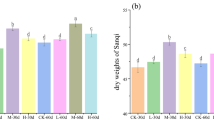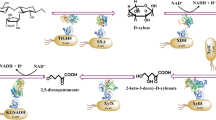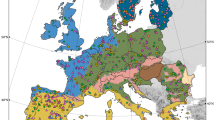Abstract
Forest ecosystems need to be sustainably managed, as they are major reservoirs of biodiversity, provide important economic resources and modulate global climate. We have a poor knowledge of populations responsible for key biomass degradation processes in forest soils and the effects of forest harvesting on these populations. Here, we investigated the effects of three timber-harvesting methods, varying in the degree of organic matter removal, on putatively hemicellulolytic bacterial and fungal populations 10 or more years after harvesting and replanting. We used stable-isotope probing to identify populations that incorporated 13C from labeled hemicellulose, analyzing 13C-enriched phospholipid fatty acids, bacterial 16 S rRNA genes and fungal ITS regions. In soil microcosms, we identified 104 bacterial and 52 fungal hemicellulolytic operational taxonomic units (OTUs). Several of these OTUs are affiliated with taxa not previously reported to degrade hemicellulose, including the bacterial genera Methylibium, Pelomonas and Rhodoferax, and the fungal genera Cladosporium, Pseudeurotiaceae, Capronia, Xenopolyscytalum and Venturia. The effect of harvesting on hemicellulolytic populations was evaluated based on in situ bacterial and fungal OTUs. Harvesting treatments had significant but modest long-term effects on relative abundances of hemicellulolytic populations, which differed in strength between two ecozones and between soil layers. For soils incubated in microcosms, prior harvesting treatments did not affect the rate of incorporation of hemicellulose carbon into microbial biomass. In six ecozones across North America, distributions of the bacterial hemicellulolytic OTUs were similar, whereas distributions of fungal ones differed. Our work demonstrates that diverse taxa in soil are hemicellulolytic, many of which are differentially affected by the impact of harvesting on environmental conditions. However, the hemicellulolytic capacity of soil communities appears resilient.
Similar content being viewed by others
Log in or create a free account to read this content
Gain free access to this article, as well as selected content from this journal and more on nature.com
or
References
Biely P, Krátký Z, Kocková-Kratochvílová A, Bauer Š . (1978). Xylan-degrading activity in yeasts: growth on xylose, xylan and hemicelluloses. Folia Microbiol 23: 366–371.
Bligh E, Dyer WJ . (1959). A rapid method of total lipid extraction and purification. Can J Biochem Physiol 37: 911–917.
Canadell JG, Raupach MR . (2008). Managing forests for climate change mitigation. Science 320: 1456–1457.
Chávez R, Bull P, Eyzaguirre J . (2006). The xylanolytic enzyme system from the genus Penicillium. J Biotechnol 123: 413–433.
Cheng C-L, Chang J-S . (2011). Hydrolysis of lignocellulosic feedstock by novel cellulases originating from Pseudomonas sp. CL3 for fermentative hydrogen production. Bioresour Technol 102: 8628–8634.
Coenye T, Vandamme P . (2003). Diversity and significance of Burkholderia species occupying diverse ecological niches. Environ Microbiol 5: 719–729.
Cole JR, Wang Q, Cardenas E, Fish J, Chai B, Farris RJ et al. (2009). The Ribosomal Database Project: improved alignments and new tools for rRNA analysis. Nucleic Acids Res 37: D141–D145.
Conlin T, Driessche Rvd . (2000). Response of soil CO2 and O2 concentrations to forest soil compaction at the long-term soil productivity sites in central British Columbia. Can J Soil Sci 80: 625–632.
de Castro VHL, Schroeder LF, Quirino BF, Kruger RH, Barreto CC . (2013). Acidobacteria from oligotrophic soil from the Cerrado can grow in a wide range of carbon source concentrations. Can J Microbiol 59: 746–753.
Dixon P . (2003). VEGAN, a package of R functions for community ecology. J Veg Sci 14: 927–930.
Doran JW . (2002). Soil health and global sustainability: translating science into practice. Agric Ecosyst Environ 88: 119–127.
Estrada-de los Santos P, Vinuesa P, Martínez-Aguilar L, Hirsch AM, Caballero-Mellado J . (2013). Phylogenetic analysis of Burkholderia species by multilocus sequence analysis. Curr Microbiol 67: 51–60.
FAO. (2010). Rome: Global Forest Resources Assessment.
Fleming RL, Powers RF, Foster NW, Kranabetter JM, Scott DA, Ponder F Jr et al. (2006). Effects of organic matter removal, soil compaction, and vegetation control on 5-year seedling performance: a regional comparison of Long-Term Soil Productivity sites. Can J Forest Res 36: 529–550.
Frostegård Å, Tunlid A, Bååth E . (1991). Microbial biomass measured as total lipid phosphate in soils of different organic content. J Microbiol Methods 14: 151–163.
Ghio S, Di Lorenzo GS, Lia V, Talia P, Cataldi A, Grasso D et al. (2012). Isolation of Paenibacillus sp. and Variovorax sp. strains from decaying woods and characterization of their potential for cellulose deconstruction. Int J Biochem Mol Biol 3: 352.
Harazono K, Yamashita N, Shinzato N, Watanabe Y, Fukatsu T, Kurane R . (2003). Isolation and characterization of aromatics-degrading microorganisms from the gut of the lower termite Coptotermes formosanus. Biosci Biotechnol Biochem 67: 889–892.
Hartmann M, Howes CG, VanInsberghe D, Yu H, Bachar D, Christen R et al. (2012). Significant and persistent impact of timber harvesting on soil microbial communities in Northern coniferous forests. ISME J 6: 2199–2218.
Hong J-Y, Kim Y-H, Jung M-H, Jo C-W, Choi J-E . (2011). Characterization of Xylanase of Cladosporium cladosporioides H1 isolated from Janggyeong Panjeon in Haeinsa Temple. Mycobiology 39: 306–309.
Johnson DW, Curtis PS . (2001). Effects of forest management on soil C and N storage: meta analysis. Forest Ecol Manag 140: 227–238.
Keenan RJ, Kimmins JP . (1993). The ecological effects of clear-cutting. Environ Rev 1: 121–144.
Khan H, Chung EJ, Jeon CO, Chung YR . (2013a). Mucilaginibacter gynuensis sp. nov., isolated from rotten-wood. Int J Syst Evol Microbiol 63: 3225–3231.
Khan H, Chung EJ, Kang DY, Jeon CO, Chung YR . (2013b). Mucilaginibacter jinjuensis sp. nov., with xylan-degrading activity. Int J Syst Evol Microbiol 63: 1267–1272.
Kõljalg U, Nilsson RH, Abarenkov K, Tedersoo L, Taylor AFS, Bahram M et al. (2013). Towards a unified paradigm for sequence-based identification of fungi. Mol Ecol 22: 5271–5277.
Kranabetter JM, Wylie T . (1998). Ectomycorrhizal community structure across forest openings on naturally regenerated western hemlock seedlings. Can J Botany 76: 189–196.
Kranabetter JM, Sanborn P, Chapman BK, Dube S . (2006). The contrasting response to soil disturbance between lodgepole pine and hybrid white spruce in subboreal forests. Soil Sci Soc Am J 70: 1591–1599.
Kurz WA, Stinson G, Rampley GJ, Dymond CC, Neilson ET . (2008). Risk of natural disturbances makes future contribution of Canada's forests to the global carbon cycle highly uncertain. Proc Natl Acad Sci 105: 1551–1555.
Maki ML, Idrees A, Leung KT, Qin W . (2012). Newly isolated and characterized bacteria with great application potential for decomposition of lignocellulosic biomass. J Mol Microbiol Biotechnol 22: 156–166.
Mohana S, Shah A, Divecha J, Madamwar D . (2008). Xylanase production by Burkholderia sp. DMAX strain under solid state fermentation using distillery spent wash. Bioresour Technol 99: 7553–7564.
Moore-Kucera J, Dick R . (2008). PLFA profiling of microbial community structure and seasonal shifts in soils of a douglas-fir chronosequenprofiling of microbial community structure and seasonal shifts in soils of a douglas-fir chronosequence. Microb Ecol 55: 500–511.
Morosoli R, Zalce E, Durand S . (1993). Secretion of a Cryptococcus albidus xylanase in Pichia stipitis resulting in a xylan fermenting transformant. Curr Genet 24: 94–99.
Nakatsu CH, Hristova K, Hanada S, Meng X-Y, Hanson JR, Scow KM et al. (2006). Methylibium petroleiphilum gen. nov., sp. nov., a novel methyl tert-butyl ether-degrading methylotroph of the Betaproteobacteria. Int J Syst Evol Microbiol 56: 983–989.
Neufeld JD, Vohra J, Dumont MG, Lueders T, Manefield M, Friedrich MW et al. (2007). DNA stable-isotope probing. Nat Protoc 2: 860–866.
Oravecz O, Elhottová D, Krištůfek V, Šustr V, Frouz J, Tříska J et al. (2004). Application of ARDRA and PLFA analysis in characterizing the bacterial communities of the food, gut and excrement of saprophagous larvae ofPenthetria holosericea (Diptera: Bibionidae): a pilot study. Folia Microbiol 49: 83–93.
Pankratov TA, Dedysh SN . (2010). Granulicella paludicola gen. nov., sp. nov., Granulicella pectinivorans sp. nov., Granulicella aggregans sp. nov. and Granulicella rosea sp. nov., acidophilic, polymer-degrading acidobacteria from Sphagnum peat bogs. Int J Syst Evol Microbiol 60: 2951–2959.
Pérez J, Muñoz-Dorado J, de la Rubia T, Martínez J . (2002). Biodegradation and biological treatments of cellulose, hemicellulose and lignin: an overview. Int Microbiol 5: 53–63.
Ponder F Jr, Fleming RL, Berch S, Busse MD, Elioff JD, Hazlett PW et al. (2012). Effects of organic matter removal, soil compaction and vegetation control on 10th year biomass and foliar nutrition: LTSP continent-wide comparisons. Forest Ecol Manag 278: 35–54.
Powers R . (1999). On the sustainable productivity of planted forests. New Forests 17: 263–306.
Powers RF, Andrew Scott D, Sanchez FG, Voldseth RA, Page-Dumroese D, Elioff JD et al. (2005). The North American long-term soil productivity experiment: Findings from the first decade of research. Forest Ecol Manag 220: 31–50.
Powers RF . (2006). Long-Term Soil Productivity: genesis of the concept and principles behind the program. Can J Forest Res 36: 519–528.
Prescott CE, Blevins LL, Staley CL . (2000). Effects of clear-cutting on decomposition rates of litter and forest floor in forests of British Columbia. Can J Forest Res 30: 1751–1757.
Quast C, Pruesse E, Yilmaz P, Gerken J, Schweer T, Yarza P et al. (2013). The SILVA ribosomal RNA gene database project: improved data processing and web-based tools. Nucleic Acids Res 41: D590–D596.
Rawat SR, Männistö MK, Starovoytov V, Goodwin L, Nolan M, Hauser L et al. (2014). Complete genome sequence of Granulicella tundricola type strain MP5ACTX9(T), an Acidobacteria from tundra soil. Stand Genom Sci 9: 449–461.
Redlak K, Dahm H, Ciesielska A, Strzelczyk E . (2001). Enzymatic activity of ectendomycorrhizal fungi. Biol Fert Soils 33: 83–90.
Salles JF, Van Veen JA, Van Elsas JD . (2004). Multivariate analyses of Burkholderia species in soil: effect of crop and land use history. Appl Environ Microbiol 70: 4012–4020.
Sanchez FG, Scott DA, Ludovici KH . (2006). Negligible effects of severe organic matter removal and soil compaction on loblolly pine growth over 10 years. Forest Ecol Manag 227: 145–154.
Schloss PD, Gevers D, Westcott SL . (2011). Reducing the effects of PCR amplification and sequencing artifacts on 16 S rRNA-Based Studies. PLoS ONE 6: e27310.
Schloss PD, Westcott SL . (2011). Assessing and improving methods used in operational taxonomic unit-based approaches for 16 S rRNA gene sequence analysis. Appl Environ Microbiol 77: 3219–3226.
Shallom D, Shoham Y . (2003). Microbial hemicellulases. Curr Opin Microbiol 6: 219–228.
Simard SW, Jones MD, Durall DM, Hope GD, Stathers RJ, Sorensen NS et al. (2003). Chemical and mechanical site preparation: effects on Pinus contorta growth, physiology, and microsite quality on grassy, steep forest sites in British Columbia. Can J Forest Res 33: 1495–1515.
Sinsabaugh RL, Antibus RK, Linkins AE, McClaugherty CA, Rayburn L, Repert D et al. (1993). Wood decomposition: nitrogen and phosphorus dynamics in relation to extracellular enzyme activity. Ecology 74: 1586–1593.
Song J, Cho J-C . (2007). Methylibium aquaticum sp. nov., a betaproteobacterium isolated from a eutrophic freshwater pond. Int J Syst Evol Microbiol 57: 2125–2128.
Štursová M, Žifčáková L, Leigh MB, Burgess R, Baldrian P . (2012). Cellulose utilization in forest litter and soil: identification of bacterial and fungal decomposers. FEMS Microbiol Ecol 80: 735–746.
Swift MJ, Heal OW, Anderson JM . (1979) Decomposition in Terrestrial Ecosystems vol. 5 University of California Press: Los Angeles, CA, USA.
Talia P, Sede SM, Campos E, Rorig M, Principi D, Tosto D et al. (2012). Biodiversity characterization of cellulolytic bacteria present on native Chaco soil by comparison of ribosomal RNA genes. Res Microbiol 163: 221–232.
Tedersoo L, Kõljalg U, Hallenberg N, Larsson K-H . (2003). Fine scale distribution of ectomycorrhizal fungi and roots across substrate layers including coarse woody debris in a mixed forest. New Phytol 159: 153–165.
Trevor EY, Egger KN, Peterson LR . (2001). Ectendomycorrhizal associations–characteristics and functions. Mycorrhiza 11: 167–177.
Turner S, Pryer KM, Miao VP, Palmer JD . (1999). Investigating deep phylogenetic relationships among cyanobacteria and plastids by small subunit rRNA sequence analysis. J Eukar Microbiol 46: 327–338.
Untereiner WA, Malloch D . (1999). Patterns of substrate utilization in species of capronia and allied black yeasts: ecological and taxonomic implications. Mycologia 91: 417–427.
Van Der Heijden MGA, Bardgett RD, Van Straalen NM . (2008). The unseen majority: soil microbes as drivers of plant diversity and productivity in terrestrial ecosystems. Ecol Lett 11: 296–310.
VanInsberghe D, Maas KR, Cardenas E, Strachan CR, Hallam SJ, Mohn WW . (2015). Non-symbiotic Bradyrhizobium ecotypes dominate North American forest soils. ISME J e-pub ahead of print 24 April 2015; doi:10.1038/ismej.2015.54.
Varnaitċ R, Raudonienċ V . (2008). Destruction of hemicellulose in rye straw by micromycetes. Ekologija 54: 169–172.
Ward NL, Challacombe JF, Janssen PH, Henrissat B, Coutinho PM, Wu M et al. (2009). Threegenomes from the phylum acidobacteria provide insight into the lifestyles of these microorganisms in soils. Appl Environ Microbiol 75: 2046–2056.
Weisburg WG, Barns SM, Pelletier DA, Lane DJ . (1991). 16 S ribosomal DNA amplification for phylogenetic study. J Bacteriol 173: 697–703.
White TJ, Bruns T, Lee S, Taylor J . (1990). Amplification and direct sequencing of fungal ribosomal RNA genes for phylogenetics. PCR Protoc 18: 315–322.
Wilhelm R, Szeitz A, Klassen TL, Mohn WW . (2014). Sensitive, efficient quantitation of 13c-enriched nucleic acids via ultrahigh-performance liquid chromatography–tandem mass spectrometry for applications in stable isotope probing. Appl Environ Microbiol 80: 7206–7211.
Zeng J, Zheng Y, Yu X, Yu L, Gao D, Chen S . (2013). Lignocellulosic biomass as a carbohydrate source for lipid production by Mortierella isabellina. Bioresour Technol 128: 385–391.
Acknowledgements
This study was supported by grants from Genome Canada and Genome BC. Kendra R Maas was supported by a postdoctoral fellowship from the Tula foundation and Roland C Wilhelm was supported by the Alexander Graham Bell Canada Graduate Scholarship (CGS) from the Natural Sciences and Engineering Research Council of Canada. We thank participants of the LTSP Study, including S Berch, C Bulmer, MD Busse, WK Chapman, RL Fleming, PW Hazlett, G Hope, JM Kranabetter, DM Morris, DA Scott, K Webster, for access to field sites, assistance sampling and soil data. We thank Larisa McNeil for soil processing and DNA extractions. We thank Pedro Dimitriu and Erick Cardenas for helpful discussions during data analysis. We also thank the contribution of scientists at the McGill University and Genome Quebec Innovation Center, Montreal, Canada for their 454 pyrosequencing service.
Author information
Authors and Affiliations
Corresponding authors
Ethics declarations
Competing interests
The authors declare no conflict of interest.
Additional information
Supplementary Information accompanies this paper on The ISME Journal website
Supplementary information
Rights and permissions
About this article
Cite this article
Leung, H., Maas, K., Wilhelm, R. et al. Long-term effects of timber harvesting on hemicellulolytic microbial populations in coniferous forest soils. ISME J 10, 363–375 (2016). https://doi.org/10.1038/ismej.2015.118
Received:
Revised:
Accepted:
Published:
Issue date:
DOI: https://doi.org/10.1038/ismej.2015.118
This article is cited by
-
Bacterial contributions to delignification and lignocellulose degradation in forest soils with metagenomic and quantitative stable isotope probing
The ISME Journal (2019)
-
Effects of timber harvesting on the genetic potential for carbon and nitrogen cycling in five North American forest ecozones
Scientific Reports (2018)
-
Insight into the cold adaptation and hemicellulose utilization of Cladosporium neopsychrotolerans from genome analysis and biochemical characterization
Scientific Reports (2018)
-
Feed in summer, rest in winter: microbial carbon utilization in forest topsoil
Microbiome (2017)
-
A metagenomic survey of forest soil microbial communities more than a decade after timber harvesting
Scientific Data (2017)



